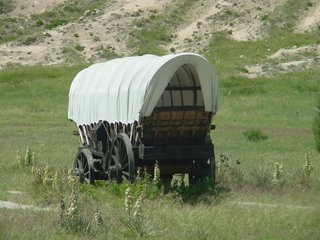Heading West
Did you know that without the Oregon Trail, most of the American west, including states like
Oregon,
California,
Nevada,
Idaho,
Utah, and
Washington would today be part of
Canada or
Mexico?
Around 1843, people began to head West, due to overpopulated land in the northeastern coast of the nation. They looked to the West for better living space and also for new opportunities and exploration.
The Oregon Trail was the best land route for travel to the western
United States.
It was the only practical way for settlers in wagons with their tools, livestock, and supplies to cross the mountains.
The journey on the Oregon Trail usually began at Independence, Missouri near the Missouri River. During a period of about six months, families traveled through prairies, deserts, and across mountains to the Pacific Northwest. The journey was a difficult test of strength and endurance.
Are you ready to ‘pull-up-stakes' and head West with your ‘family’ for an exciting, yet dangerous journey on the Oregon Trail? Using the websites provided, you will gather information about the experiences of pioneers traveling on the Oregon Trail. Think about how they traveled, sites they saw, supplies they took and used, hardships they endured, etc.
After completing the two web site assignments, you will complete a project, putting yourself in the shoes of a pioneer on the Oregon Trail. You are going to write a letter to your relatives once you make it to Oregon, telling them about your experience on the Trail. As you complete the following assignments, think about what you might tell your family members.










